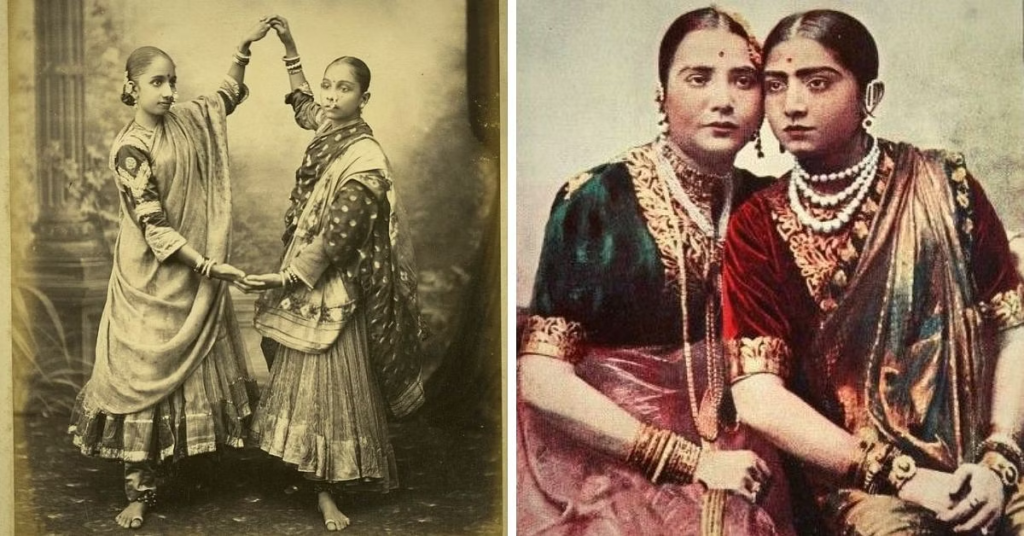
These highly skilled courtesans sang, danced, wrote poetry, and were the purveyors of all that was considered good taste and high fashion. Tawaifs, the Awadhi term for highly skilled courtesans, rose to prominence between the 18th and 19th centuries in the royal courts of Awadh, part of present-day Uttar Pradesh.

For the majority of us, our exposure to tawaifs and their way of life has mainly been through their depiction in popular Bollywood cinema. When we come across the word ‘Tawaif’. The first image that comes to our mind is that of a sensual seductress, equivalent to prostitutes. Iconic movies like Devdas, Umrao Jaan, Pakheeza, and Mughal-E-Azam portrayed the tawaif as a fallen woman. Wrapping up their stories with admonitory diktats on morality. Their existence in these narratives was limited to arousing either desire or pity in the heart of the audience. However, the lives of tawaifs were much more nuanced than their Bollywood portrayal.
The word tawaif comes from “tauf”, which means to go round and round. Interestingly the word “tawwaf” or circumbulation of the Holy Kaaba also comes from tauf. Tauf was used for a band of iterant musicians. Tawaifs were highly skilled musicians, singers and dancers, they were given this name. It was a term of respect not derision.

In the 16th Ain-e-Akbari, which details Akbar’s administration. There is a chapter on the classes of singers and a description of a class called “Kanjari”:
“The Kanjarí: The men of this class play the Pakháwaj, the Rabáb, and the Tála, while the women sing and dance. His Majesty calls them Kanchanís. Their extraordinary performances are beyond description and each affects a special vocal accompaniment style.”
The girls were trained in music and dance from the age of five-seven. By the time they were 10-12, they would accompany older girls in small-sized gatherings. As they grew up they would be attached to some rich patron.

Famous Tawaif in early times
Begum Samru ( 1753 – 1836)
Begum Samru was a tawaif, who arose to become the ruler of the Principality of Sardhana. As a very young girl, she came to live with a European expatriate by the name of Walter Reinhardt Sombre. He was the leader of a mercenary army comprised of both native as well as European soldiers. Upon his death, she assumed command of this army. Using her extraordinary political, and military abilities, became the ruler of Sardhana. She enjoyed this position until she died in 1836.
Moran Sarkar
Moran Sarakar was a tawaif who rose to become Queen. She became the wife of the Maharaja Ranjit Singh (1780-1839) in 1802. She was considered to be very learned in the arts and letters and was respected for her philanthropy. It is interesting to note that even though Maharaja Ranjit Singh never minted a coin with his own image. He did mint coins with her image.
Umrao Jaan Ada
It is impossible to discuss the tawaifs without mentioning Umrao Jaan of Lucknow. Unfortunately, various films and novels have taken such artistic liberties with her life. That she exists more as a legend than an actual person. We know for sure that a tawaif by the name of Umrao Jaan existed. But that is about all that we can be certain of. The only details of her life come through the “Umra-o-Jaan-e-Ada”. This was a novel written in 1905 by Mirza Mohammed Hadi Ruswa. Undoubtedly artistic liberties were taken in the book. With the result that we are just unable to tell fact from fiction. Therefore it is probably better if we exclude her from our discussions here.

Downfall of Tawaifs in colonial era
They appeared, surprisingly, in the civic tax ledgers of 1858-77 and in the related official correspondence preserved in the Municipal Corporation records room. They were classed under the occupational category of “dancing and singing girls,”. As if it was not surprise enough to find women in the tax records. It was even more remarkable that they were in the highest tax bracket, with the largest individual incomes of any in the city. The courtesans’ names were also on lists of property: (houses, orchards, manufacturing and retail establishments for food and luxury items) confiscated by British officials for their proven involvement in the siege of Lucknow and the r
The British usurpation of the Kingdom of Awadh in 1856. The forced exile of the king and many of his courtiers, had abruptly put an end to royal patronage for the courtesans. The imposition of the contagious diseases regulations and heavy fines and penalties on the courtesans for their role in the rebellion signaled the gradual debasement of an esteemed cultural institution into common prostitution.

Women who had once consorted with kings and courtiers, enjoyed a fabulously opulent living, manipulated men and means for their own social and political ends, been the custodians of culture and the setters of fashion trends. They were left in an extremely dubious and vulnerable position under the British. “Singing and dancing girls” was the classification invented to describe them in the civic tax ledgers. Encapsulates one of the many profound cultural misunderstandings of “exotic” Indian women by colonial authorities.
However, some of the tawa’ifs survived the Mutiny of 1857 and Independence and they still operate in Lucknow in private. Many tawa’ifs, including Jaddan Bai and her later famous daughter Nargis, found work in Bombay in the mainstream Hindi film industry.

Prostitutes today
Today, the word tawaif is used for a woman in the flesh trade. Those that learn to sing and dance no longer sing Ghalib or Dagh’s ghazals. Moreover, they gyrate to lewd double-meaning film songs to titillate the customer.
There are no balakhanas, where music and dance flourished. Just kothas where more often than not, girls are kidnapped, lured, and forced into the flesh trade against their will.

